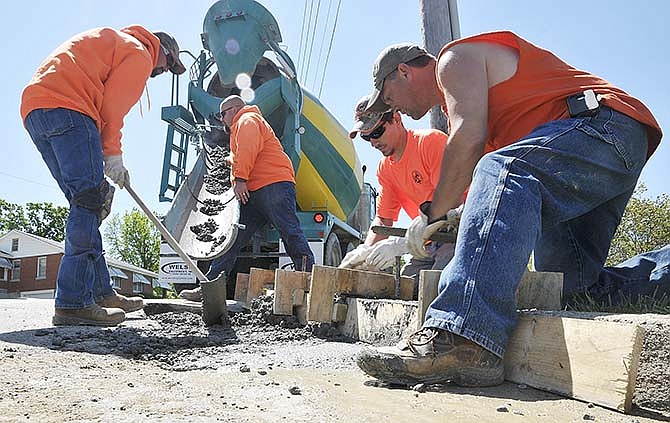While Jefferson City has seen its borders grow in the last 65 years, the Public Works Department staff has shrunk, leaving limited resources to handle the increased workload.
In 2013, the city discovered an unexpected budget shortfall of $1.68 million, which led to a near hiring freeze and programs aimed at urging eligible city employees to retire early. Since then, the Public Works Department has lost 11 positions, both full-time and seasonal, with five being lost in engineering design services and the rest being maintenance and seasonal positions in the street division.
In the engineering division, as Public Works Director Matt Morasch wrote in a Feb. 11 memo to the city administrator, the effect of the loss of the design positions "is just now being realized."
The cuts to the division have left only one staff member in engineering design services, which means many more projects will have to be designed by paid consultants.
"To compensate for this loss, over the last year staff shifted much of the design work to outside consultants," Morasch wrote. "The consulting fees will also "eat' into the funds available to complete projects, so in the end, fewer projects will be accomplished than in years past."
Morasch said the department has only formally requested reinstating one additional engineering design position, which he hopes will be addressed in the 2016 budget, though that will depend on both available resources and overall city priorities.
In the street division, Morasch wrote in his memo that the loss of seasonal and maintenance positions has created a level-of-service issue.
"The discussion is similar to the one MoDOT is having now about its ability to maintain roadways," Morasch wrote. "On a smaller scale, it is the same issue that lack of, or reduction of, preventable maintenance will show itself in the long term as increased costs to repair of the basic infrastructure system."
Morasch wrote that before the 2013 cuts, the department had been considering a request for additional staff positions in the street division to handle the amount of needed maintenance.
The street division has not grown in more than 50 years, even as the city expands its limits and becomes responsible for more miles of road. In fact, the loss of positions since 2013 shrank the street division staff even lower than it was in 1953, when the city was responsible for 9.14 square miles of land. It is now responsible for 37.17 square miles of land.
"The thing about infrastructure is you can cut back on it. ... but in five years from now, it will catch up to you and then repairs are more costly and bigger," Morasch said.
Aside from the city's growth, Morasch and Operations Division Director Britt Smith said increased regulations, traffic and other factors have made it far more costly to maintain infrastructure since the 1950s.
"It's just a different world," Smith said.
To deal with both staff and budget cuts, Morasch wrote in the February memo that the department has made several changes to help ease costs and responsibilities, including shifting maintenance work to be more complaint-driven instead of proactive; nearly eliminating the crack-seal program, which was meant to help extend the life of pavement roads without a more expensive overlay; and eliminating the manning position at the East Miller Street salt storage location during snow events.
"Every time you take away a few people, it's harder to get people to go out proactively looking for these things," Morasch said. "We're doing the best we can."
Morasch's memo also described measures the department still could pursue to further ease constraints.
These measures included charging event organizers for rental and placement of street closure barricades; limiting pothole repair work to certain days, to allow the dedicated pothole crew to work on other projects and priorities; reducing the mowing of city right-of-ways and other properties from five times per year to two or three times per year; and reducing the street-sweeping from six times per year to three times per year for all city streets, except in the downtown area, which is currently swept weekly and would be reduced to every other week.
"We're looking for anything we can do to stretch our manpower," Smith said. "We're taking a look at our operations and saying, "Is there anything we can stop doing?' And we really can't find anything that we can stop doing. So the only thing that's left is we need to do them less."
Smith and Morasch said none of the measures have been implemented so far.
Smith said he attended the spring conference of the Missouri chapter of the American Public Works Association, held in Jefferson City last week, and spoke to people dealing with the same issues across the country.
"Everyone is facing the same ... dilemma," Smith said.

